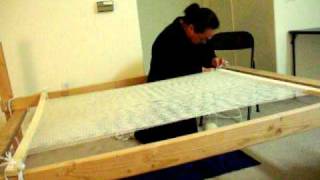Friday, 26 December, 2025г.
















Где искать: по сайтам Запорожской области, статьи, видео ролики
пример: покупка автомобиля в Запорожье
Native American Indian Rugs and Blankets how to identify a Navajo Rug
Navajo textile expert Dr. Mark Sublette of Medicine Man Gallery gives tips on how to determine if a weaving is a Navajo rug. Excellent tutorial for beginning collectors on what are the characteristics to look for when buying a Navajo weaving. Website: https://www.medicinemangallery.com Facebook: https://www.facebook.com/medicinemangallery Instagram: https://www.instagram.com/medicinemangallery Native American Indian Rugs and Blankets how to identify a Navajo Rug A question I always get asked: how do you know it's a Navajo rug? Well, it's a very important distinction to know how a piece is a Navajo rug versus a fake, a fraud, or something that is just similar, but not the same value. There's a couple of things that you look for that are very characteristic of Navajo rugs. This doesn't mean you'll always see it because, unfortunately, with fakes and frauds people now have even started to put these little characteristics into the weavings. First of all, a Navajo rug is done on a continuous loom. This means that the loom itself has the warps which go up and down completely, and you can look at this. Now, a lot of the fakes, like Mexican fakes, make it where they're trying to make it look like a Navajo rug have actually cut the warps turn them back around, and you can't see it – it looks like it is it continuous warp, so it's very important to look on the sides and see with your hands if it's continuous or if they just flipped it around. All Navajo rugs pretty much are going to be continuous except some very examples of Germantown - you can look for lazy lines. Now, contemporary weavings will not have this because they're trying to make the rug more perfect but the older rugs 1950s and before, and blankets you're going to see these distinguishing characteristics called lazy lines. The term has come from the fact that while the Navajo weavers were weaving they would move once they got to a certain section, and thus it would make the diagonal line that you see here in this Navajo weaving. The third thing that you can look for in a Navajo weaving is the sides or the selvage. In Mexican pieces often that's not a salvage like a Navajo weaving, but in the Navajo textiles you'll often see this line or salvage cord. So, the three things that you really should look for again when you're looking to see if it's a Navajo rug are: 1) look for a lazy line 2) see if it's a continuous warp and 3) look at the salvage. Finally, the one thing that I always look for, and unfortunately, it will take you experience is just wool. If you feel the wool and it's dense and very well packed, that probably means it's a hand spun rug and probably Navajo. Mexican textiles, especially the ones which are made to be “Navajo style” and that's a key word, because if you ever look on an eBay and you see Navajo style that's a code for Mexican reproduction – nice weavings but not worth what a Navajo is. This is Mark Sublette. Hope it helped.
Теги:
Navajo Navajo rugs navajo blankets buying navajo rugs prices for navajo rugs selling navajo rugs selling navajo blankets how much is my Navajo rug worth navajo weavings Indian rugs
Похожие видео
Мой аккаунт


 У вашего броузера проблема в совместимости с HTML5
У вашего броузера проблема в совместимости с HTML5


